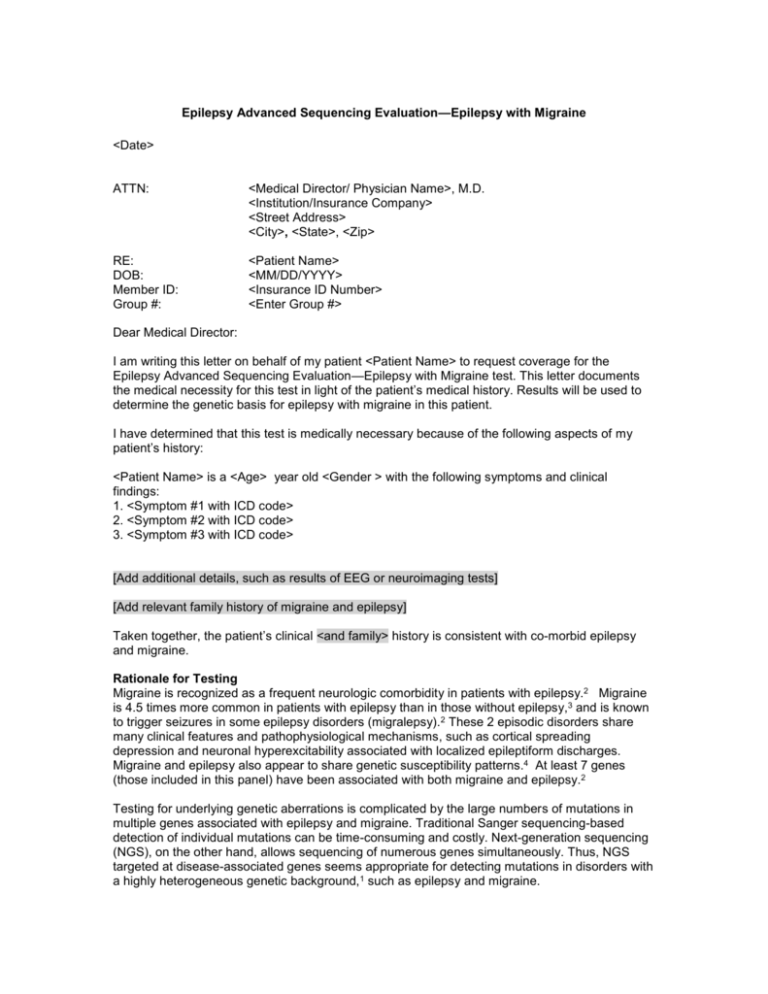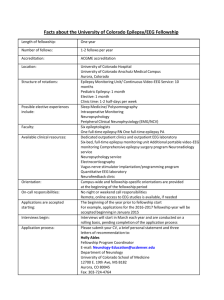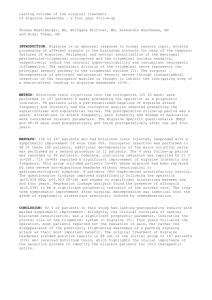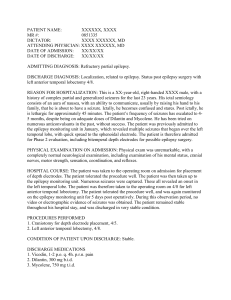Epilepsy with Migraine - Test Code 5006
advertisement

Epilepsy Advanced Sequencing Evaluation—Epilepsy with Migraine <Date> ATTN: <Medical Director/ Physician Name>, M.D. <Institution/Insurance Company> <Street Address> <City>, <State>, <Zip> RE: DOB: Member ID: Group #: <Patient Name> <MM/DD/YYYY> <Insurance ID Number> <Enter Group #> Dear Medical Director: I am writing this letter on behalf of my patient <Patient Name> to request coverage for the Epilepsy Advanced Sequencing Evaluation—Epilepsy with Migraine test. This letter documents the medical necessity for this test in light of the patient’s medical history. Results will be used to determine the genetic basis for epilepsy with migraine in this patient. I have determined that this test is medically necessary because of the following aspects of my patient’s history: <Patient Name> is a <Age> year old <Gender > with the following symptoms and clinical findings: 1. <Symptom #1 with ICD code> 2. <Symptom #2 with ICD code> 3. <Symptom #3 with ICD code> [Add additional details, such as results of EEG or neuroimaging tests] [Add relevant family history of migraine and epilepsy] Taken together, the patient’s clinical <and family> history is consistent with co-morbid epilepsy and migraine. Rationale for Testing Migraine is recognized as a frequent neurologic comorbidity in patients with epilepsy.2 Migraine is 4.5 times more common in patients with epilepsy than in those without epilepsy,3 and is known to trigger seizures in some epilepsy disorders (migralepsy).2 These 2 episodic disorders share many clinical features and pathophysiological mechanisms, such as cortical spreading depression and neuronal hyperexcitability associated with localized epileptiform discharges. Migraine and epilepsy also appear to share genetic susceptibility patterns.4 At least 7 genes (those included in this panel) have been associated with both migraine and epilepsy.2 Testing for underlying genetic aberrations is complicated by the large numbers of mutations in multiple genes associated with epilepsy and migraine. Traditional Sanger sequencing-based detection of individual mutations can be time-consuming and costly. Next-generation sequencing (NGS), on the other hand, allows sequencing of numerous genes simultaneously. Thus, NGS targeted at disease-associated genes seems appropriate for detecting mutations in disorders with a highly heterogeneous genetic background,1 such as epilepsy and migraine. The Epilepsy Advanced Sequencing Evaluation—Epilepsy with Migraine test uses NGS to simultaneously identify mutations in 7 genes that have been associated with epilepsy with migraine: CACNA1A (familial hemiplegic migraine-1; familial hemiplegic migraine with progressive cerebellar ataxia-1); ATP1A2 (familial basilar migraine; familial hemiplegic migraine2); SCN1A (familial hemiplegic migraine-3); NOTCH3 (migraine associated with cerebral arteriopathy with subcortical infarcts and leukoencephalopathy [CADASIL]); POLG (migraine associated with mitochondrial recessive ataxia syndrome [includes SANDO and SCAE]); PRRT2 (migraines associated with seizures, benign familial infantile-2); and SLC2A1 (migraine associated with dystonia-9).1 This NGS test may provide several important benefits for my patient: 1) Results may help establish the diagnosis of the specific type of epilepsy with migraine. 2) Because the NGS assay covers multiple relevant genes using single blood draw, it can potentially help avoid additional diagnostic procedures. 3) Results may allow genetic counseling for relatives. In summary, I am requesting that <Patient Name> be approved for the Epilepsy Advanced Sequencing Evaluation – Epilepsy with Migraine (test code 5006) offered by Athena Diagnostics; CPT codes 81405 (x1), 81406 (x3), 81407 (x1), and 81479 (x1). Results from this test could minimize additional testing. I hope that you support my decision to pursue NGS testing for my patient. Please feel free to contact me at <Physician Phone> if you have additional questions. Sincerely, <Physician Name>, MD NPI #: <Physician NPI#> Contact information: < Address> <City>, <State>, <Zip> Contact Phone No.: <phone number> References 1. Lemke JR, Riesch E, Scheurenbrand T, et al. Targeted next generation sequencing as a diagnostic tool in epileptic disorders. Epilepsia. 2012;53:1387-1398. 2. Bianchin MM, Londero RG, Lima JE, et al. Migraine and epilepsy: a focus on overlapping clinical, pathophysiological, molecular, and therapeutic aspects. Curr Pain Headache Rep. 2010;14:276-283. 3. Oakley CB, Kossoff EH. Migraine and epilepsy in the pediatric population. Curr Pain Headache Rep. 2014;18:402. 4. Winawer MR, Connors R. Evidence for a shared genetic susceptibility to migraine and epilepsy. Epilepsia. 2013;54:288-295.





